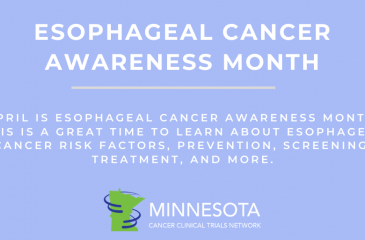Esophageal Cancer Awareness Month: Prevention & Barrett’s Esophagus
April is Esophageal Cancer Awareness Month in the United States. Esophageal cancer is cancer of the esophagus, the tube that carries food, liquid, and saliva from the mouth to the stomach. There are two main types of esophageal cancer. Squamous cell carcinoma affects the squamous cells lining the entire esophagus. Esophageal adenocarcinoma affects glandular cells in the lower part of the esophagus near the entrance to the stomach.
Esophageal cancer is a less common cancer, making up about one percent of cancers diagnosed in the United States. However, incidence of this cancer has increased markedly over the past 40 years and the survival rate is low. In 2021, it is estimated that more than 19,000 new cases of esophageal cancer will be diagnosed, and more than 15,000 people will die from esophageal cancer.
Men are more than three times more likely to be diagnosed with esophageal cancer than women. Survival rates for esophageal cancer have increased in recent years, with 20 percent of patients surviving five years after diagnosis.
The main risk factors for esophageal cancer are behaviors that irritate the esophagus. Some of these irritants include cigarettes, other tobacco products, and alcohol. Diet and obesity are other significant factors. Another risk factor is gastrointestinal reflux disease (GERD), also known as acid reflux. This chronic illness occurs when acid from the stomach escapes into the esophagus. Over time, stomach acids can damage cells in the esophagus, sometimes leading to a condition called Barrett’s esophagus. This is considered a precancerous condition, or a potential precursor to cancer, in this case esophageal adenocarcinoma.
Barrett’s esophagus occurs when damage to cells in the lower esophagus called squamous cells causes those cells to change and be replaced by a different type of cells called columnar epithelium. These cells resemble the lining of the intestines. These cells may divide, alter shape, or change further and are more likely to cause cancer. This is called dysplasia. The severity of dysplasia is referred to as either low-grade or high-grade. If cancer occurs, it typically follows a step approach from low-grade dysplasia to high-grade dysplasia to carcinoma.
Studies have found that about 10 percent of those with chronic GERD will develop Barrett’s esophagus. Less than one percent of people diagnosed with Barrett’s esophagus will develop esophageal adenocarcinoma. However, clinical trials have found that the risk increases greatly for people with low-grade dysplasia (10 percent), and even more for high-grade dysplasia (40 percent).
Barret’s esophagus is a significant risk factor for esophageal adenocarcinoma and needs to be observed and monitored closely to detect cancer as early as possible if it does occur. Those with GERD also need to be monitored to detect Barrett’s esophagus early. This is typically done by undergoing an endoscopy, the insertion of a long tube into the esophagus to observe closely. Tissue from the esophagus will also be removed and examined to diagnose Barrett’s esophagus.
Because Barrett’s esophagus is often asymptomatic and only 10 percent of people with GERD will develop Barrett’s esophagus, recommendations for screening for both Barrett’s esophagus and esophageal adenocarcinoma are controversial. Some organizations recommend anyone with chronic GERD (typically with symptoms for five years or more) be screened for Barrett’s esophagus. Similarly, some organizations recommend that anyone with Barrett’s esophagus receive an endoscopy every year, or every two to three years, to check for esophageal cancer, with more frequent endoscopies recommended for people with low- or high-grade dysplasia. Other experts think both screening guidelines for Barrett’s esophagus and for esophageal adenocarcinoma may be unnecessary or excessive due to the discomfort, anxiety, complications, and costs that patients may incur from undergoing endoscopies.
Clinical trials are examining what guidelines should be for screening and diagnosis of Barrett’s esophagus, as well as determining new strategies and procedures for diagnosis that may be less disruptive and uncomfortable. One such study is the Sponge-on-a-String study, open at several MNCCTN sites, which evaluates the effectiveness of a capsule sponge device in detecting Barrett’s esophagus. The device is swallowed by the patient, and then removed via the attached string, to collect and examine esophageal cells and measure biomarkers to diagnose Barrett’s esophagus.
Clinical trials are also being conducted to determine other strategies for screening and diagnosing esophageal adenocarcinoma for those with Barrett’s esophagus. A 2014 randomized clinical trial compared endoscopic radiofrequency ablation, a procedure using an endoscope to transmit radiofrequency energy to destroy cells in Barrett’s tissue, to endoscopic surveillance to prevent esophageal adenocarcinoma. This procedure is minimally invasive, taking just 30 minutes to complete. In the study, 136 patients with Barrett’s esophagus and low-grade dysplasia were randomly assigned to receive either endoscopic radiofrequency ablation or endoscopic surveillance. After three years of follow-up, the patients who received endoscopic radiofrequency ablation were 25 percent less likely to progress to high-grade dysplasia and 7.4 percent less likely to progress to esophageal adenocarcinoma than those who received endoscopic surveillance.
Other clinical trials have examined risk factors that may contribute to Barrett’s esophagus patients developing dysplasia and/or esophageal adenocarcinoma, in hopes that these factors may help clinicians tailor guidelines to specific patients and their histories. A 2020 retrospective study observed 460 patients with Barrett’s esophagus from 1992 to 2013 and analyzed demographic and clinical data. Of the 460 patients, 132 developed high-grade dysplasia and 62 developed esophageal adenocarcinoma. From the examined patient data, researchers found that age, obesity, heavy smoking, and high caffeine intake increased the risk of developing esophageal adenocarcinoma.
Further research is needed to determine which guidelines are most effective and appropriate to screen for both Barrett’s esophagus and esophageal adenocarcinoma to ensure the best outcomes for patients. Research is also ongoing to determine what other risk factors may contribute to those with Barrett’s esophagus developing esophageal adenocarcinoma, such as family history. As with other diseases, clinical trials are the key to better understanding Barrett’s esophagus and creating the best outcomes and long-term survival for patients.
